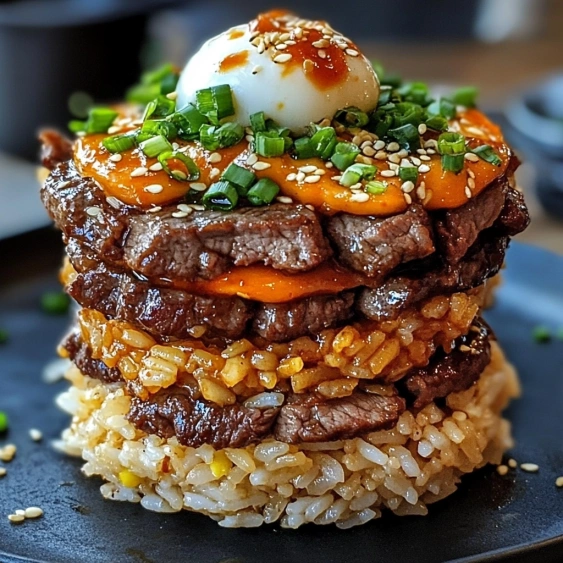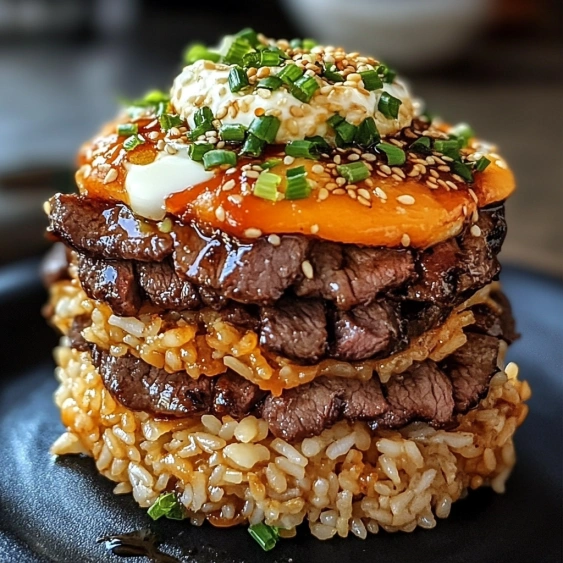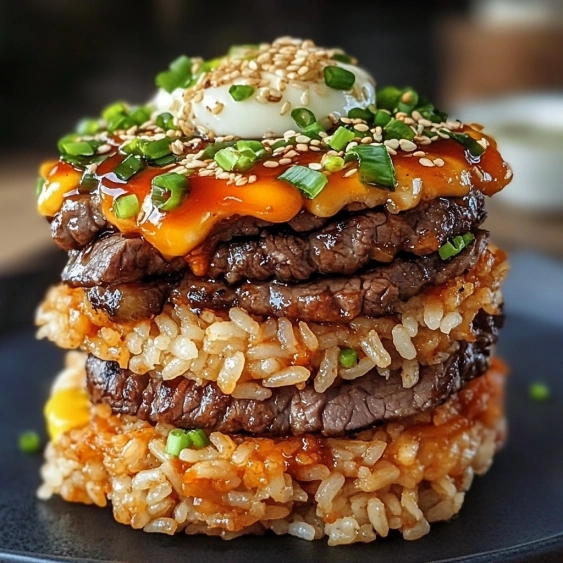 Pin it
Pin it
This Korean BBQ Beef Rice Stack transforms ordinary weeknight dinners into something extraordinary with minimal effort. The sweet-spicy glaze caramelizes perfectly on the beef, creating layers of flavor that complement the fluffy rice beneath. After discovering how to make restaurant-quality Korean BBQ at home, this dish has become my signature when friends come over for dinner.
I first created this recipe when trying to recreate the flavors from my favorite Korean restaurant. What started as an experiment has become the most requested dish when my college friends visit, bringing back memories of our late night food adventures.
Ingredients
- Korean BBQ beef: Thinly sliced for quick cooking and maximum flavor absorption
- White rice: Providing the perfect neutral base for the bold flavors above
- Sesame oil: Creates that authentic Korean aroma and nutty undertone
- Soy sauce: Adds essential umami depth to the sauce
- Gochujang: Korean chili paste brings balanced heat and sweetness
- Rice vinegar: Adds brightness to cut through the richness
- Honey: Balances the heat and helps create caramelization
- Garlic and ginger: Aromatics that form the foundation of Korean cuisine
- Green onions: Provide fresh bite and color contrast
- Cucumber: Adds refreshing crunch against the savory beef
- Sesame seeds: Contribute texture and visual appeal
- Kimchi: Traditional fermented side that adds complexity and probiotics
Step-by-Step Instructions
- Create the Signature Sauce:
- Whisk together soy sauce, gochujang, rice vinegar, honey, minced garlic, and grated ginger in a small bowl until completely smooth. This balanced sauce combines sweet, spicy, tangy and savory elements that will glaze the beef perfectly. Make sure the honey is fully incorporated for even caramelization.
- Cook the Korean BBQ Beef:
- Heat sesame oil in a skillet over medium heat until shimmering but not smoking. Add the thinly sliced Korean BBQ beef in a single layer, working in batches if necessary to avoid overcrowding. Cook until the edges begin to brown and caramelize, about 5 to 7 minutes, turning occasionally for even cooking.
- Glaze and Finish the Beef:
- Pour the prepared sauce over the cooked beef, using a wooden spoon to toss and coat each piece thoroughly. Allow the sauce to bubble and reduce slightly, clinging to the meat and creating a glossy finish. This takes about 2 to 3 minutes as the sugars in the honey caramelize and the flavors intensify.
- Assemble Your Rice Stack:
- Start with a foundation of warm rice, about half a cup, pressed firmly into the bottom of each serving bowl. The rice should be slightly sticky to help maintain the stack structure. For presentation purposes, you can use a ring mold to create a perfect circle.
- Layer the Glazed Beef:
- Arrange a generous portion of the saucy Korean BBQ beef directly on top of the rice layer. Allow some of the sauce to drip down into the rice below, flavoring it from above. The heat from the beef will continue to infuse the rice with flavor.
- Add Fresh Elements:
- Crown your creation with sliced cucumber arranged in an overlapping pattern, a scattering of green onions, and a sprinkle of toasted sesame seeds. These fresh components provide textural contrast and visual appeal against the rich beef.
- Complete the Experience:
- For an authentic Korean meal, add a small mound of kimchi alongside your stack. The fermented vegetables provide a tangy counterpoint that refreshes the palate between bites of the rich, savory stack.
 Pin it
Pin it
The first time I served this to my Korean American friend, she closed her eyes and said it reminded her of her grandmother's cooking. That moment confirmed I had captured something authentic, despite putting my own spin on the presentation. The gochujang in particular brings that distinctive Korean flavor profile that simply can't be replicated with other chili pastes.
Customize Your Rice Stack
While the recipe provides a delicious foundation, feel free to personalize your Korean BBQ Rice Stack with additional toppings. Thinly sliced carrots, spinach sautéed with garlic, or a fried egg with a runny yolk all make wonderful additions. For a refreshing element, try adding thinly sliced radishes or avocado. The stack format lends itself perfectly to creative layering, making each serving unique.
 Pin it
Pin it
Storage and Meal Prep
The components of this dish store beautifully when kept separate, making it ideal for meal preparation. Store the cooked beef with its sauce in an airtight container in the refrigerator for up to 3 days. The rice can be refrigerated for up to 4 days and reheated with a sprinkle of water to restore moisture. For the freshest presentation, slice cucumber and green onions just before serving. When ready to eat, simply reheat the beef and rice separately in the microwave, then assemble your stack.
The History Behind Korean Beef Bowls
This modern presentation draws inspiration from traditional Korean bibimbap, which literally means "mixed rice." Historically, bibimbap was created as a way to use leftover side dishes by mixing them with rice and gochujang. The stacked presentation here offers a contemporary twist on these traditional flavors, highlighting the beautiful layers rather than mixing them together. While authentic bibimbap often includes numerous vegetable preparations, this simplified version maintains the spirit while being accessible for everyday cooking.
Frequently Asked Questions
- → What can I substitute for gochujang if I can't find it?
While gochujang has a unique flavor profile, you can substitute with a mixture of 1 tablespoon sriracha, 1/2 teaspoon miso paste, and 1/2 teaspoon honey. Alternatively, Thai chili paste (sambal oelek) mixed with a bit of honey can work in a pinch, though the flavor will be slightly different.
- → Can I make this dish ahead of time?
Yes, you can prepare the beef and sauce up to 2 days ahead and store in the refrigerator. The rice can be cooked a day ahead. When ready to serve, reheat the beef in a skillet and assemble the stacks with freshly prepared garnishes for the best presentation and texture.
- → What type of rice works best for this dish?
Medium-grain white rice is traditional for Korean dishes. Short-grain sushi rice or jasmine rice also work well as they hold together nicely when stacked. For a healthier option, brown rice can be substituted but may alter the authentic texture.
- → How do I thinly slice beef if I can't find pre-sliced Korean BBQ beef?
If you can't find pre-sliced Korean BBQ beef, buy a ribeye or sirloin steak and freeze it for about 30 minutes until it's firm but not frozen solid. This makes it easier to slice thinly against the grain. You can then marinate the slices in a mix of soy sauce, sugar, garlic, and sesame oil for about 30 minutes before cooking.
- → What sides pair well with Korean BBQ Beef Rice Stack?
Traditional Korean banchan (side dishes) like kimchi, pickled daikon radish, or spinach namul complement this dish perfectly. A simple cucumber salad dressed with rice vinegar or a clear soup like miyeok-guk (seaweed soup) also make excellent accompaniments for a complete Korean meal experience.
- → Can this dish be made vegetarian?
Yes, you can replace the beef with firm tofu, tempeh, or mushrooms (portobello or king oyster work well). Marinate your chosen substitute in the same sauce mixture, then pan-fry until caramelized before assembling the stack. The flavorful sauce will still give you a delicious Korean-inspired dish.
